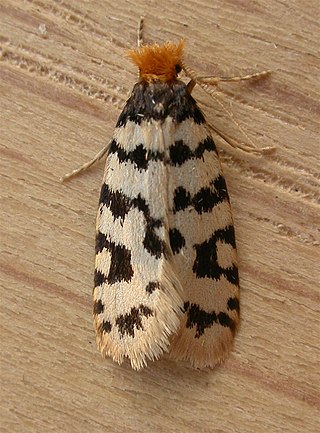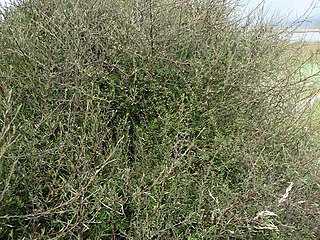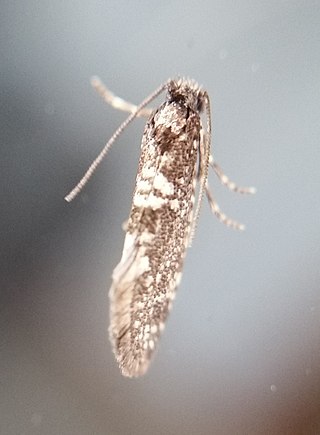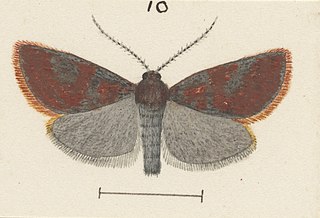
The Psychidae are a family of the Lepidoptera. The bagworm family is fairly small, with about 1,350 species described. Bagworm species are found globally, with some, such as the snailcase bagworm, in modern times settling continents where they are not native.

Heloxycanus patricki, also known as the sphagnum porina moth, is a species of moth of the family Hepialidae, the ghost moths. It is the only member of the genus Heloxycanus. This species is endemic to New Zealand. It has been classified as having the status of "At Risk, Declining" by the Department of Conservation.

Campbellana is a genus of moths of the Carposinidae family, containing only one species, Campbellana attenuata. This species is endemic to the Campbell Islands of New Zealand.

Australothis volatilis, also known as the fuzzweed moth, is a species of moth in the family Noctuidae. It is endemic to New Zealand. This species has been classified as critically endangered by the Department of Conservation.

Zealandopterix zonodoxa is a moth of the family Micropterigidae. It is endemic to New Zealand and is located from Hawkes Bay north as well as on Poor Knights, Little Barrier and the Great Barrier Islands. It is the smallest micropterigid in New Zealand and the shiny white markings on the forewing of this species display variation. It is a moth that is active during the day, but has been collected using UV light. Adults are on the wing from September to March and the species has been witnessed visiting the flowers of Nīkau and Cordyline pumilio in large numbers. It inhabits a wide variety of moist indigenous forest but is associated with forests in which podocarps are common. Larvae have been sieved from rotten wood on the floor of a mixed podocarp/broadleaf forest or extracted from moss or from bryophytes.

Mnesarchaea fallax is a species of primitive moth in the family Mnesarchaeidae. It is endemic to New Zealand. This species is found in the Taranaki, Taupo, Nelson and Buller regions. It lives in a variety of habitats such as beech forest clearings, native podocarp forest, red tussock grasslands as well as in flax wetlands and at higher altitudes of up to 1300m. Much of the life history of this species is unknown and as at 2021 the host plants of this species have yet to be confirmed. The adult moths are on the wing from October to December. This species is classified as "Not Threatened" by the Department of Conservation.

Plagianthus divaricatus or saltmarsh ribbonwood is a plant that is endemic to New Zealand. The Māori name is makaka. Other common names it is known by marsh ribbonwood, Houi and Runa.

Meterana pictula is a moth of the family Noctuidae. It is endemic to New Zealand. This species has been classified as "At Risk, Declining" by the Department of Conservation.

Meterana tartarea is a moth of the family Noctuidae. It was described by Arthur Gardiner Butler in 1877. It is endemic to New Zealand.

Scoriodyta conisalia is a species of moth in the family Psychidae. It was described by Edward Meyrick in 1888. It is endemic to New Zealand and can be found in the North Island. It has been observed at Karikari, Paihia, in the Poor Knights Islands, and in the Auckland and Wellington regions. The species inhabits native forest and coastal areas where it can be found on rocky outcrops and cliffs. Larvae consume algae and lichens. The adults are on the wing from September to March and are active before sunrise.
Scoriodyta patricki is a moth of the Psychidae family. It was described by Haettenschwiler in 1989. It is found in New Zealand.

Chersadaula ochrogastra is a species of moth in the family Oecophoridae. This species is endemic to New Zealand. It is classified as "Data Deficient" by the Department of Conservation.
Scoriodyta dugdalei is a moth of the Psychidae family. It was described by Haettenschwiler in 1989. It is endemic to New Zealand.
Scoriodyta suttonensis is a moth of the Psychidae family. It was described by Haettenschwiler in 1989. It is endemic to New Zealand. Specimens have been collected in central Otago.
Scoriodyta virginella is a moth of the Psychidae family. It was described by Haettenschwiler in 1989. It is found in New Zealand.
Scoriodyta sereinae is a moth of the Psychidae family. It was described by Haettenschwiler in 1989. It is found in New Zealand.

Pyrgotis chrysomela is a species of moth of the family Tortricidae. It is endemic to New Zealand.

Pyrgotis consentiens is a species of moth of the family Tortricidae. It is endemic to New Zealand. The holotype specimen of P. consentiens is held at the New Zealand Arthropod Collection (NZAC). Specimens of this species have also been collected on Stewart Island as well as in the Hunter Mountains.

Pyrgotis plagiatana is a species of moth of the family Tortricidae. It is found in New Zealand.

Scoriodyta is a genus of moths of the family Psychidae. It was first described by Edward Meyrick in 1888.














